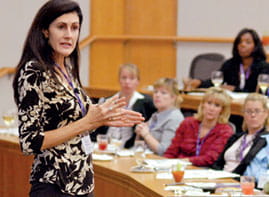A new study by Assistant Professor Loran Nordgren explores why people have a stronger emotional response to individual victims than to an entire crowd of sufferers
9/9/2010 - Joseph Stalin once claimed that a single death was a tragedy, but a million deaths was a statistic. New research from the Kellogg School validates this sentiment, confirming that large-scale tragedies don’t connect with people emotionally in the same way smaller tragedies do.
The new study, entitled “The Scope-Severity Paradox: Why doing more harm is judged to be less harmful,” has been published in the current issue of
Social Psychological and Personality Science (published by SAGE) and was conducted by
Loran Nordgren of the Kellogg School of Management and Mary-Hunter Morris of Harvard Law School. The researchers found that a “scope-severity paradox” exists in which judgment of harm tends to be based on emotional reactions, and thus people have a stronger emotional response to singular identifiable victims rather than to an entire crowd of sufferers.
“We see this time and again on the news, where a missing person is featured as a leading story for months because there is emotional interest wrapped up in that single individual,” said Nordgren, an assistant professor of management and organizations. “But, if you think of current stories, such as the Chilean miners or the people affected by the BP oil spill, we find that it’s harder to relate to those victims unless you get to know their personal stories. The bottom line is that it’s difficult for people to connect when there are many faceless victims.”
To test their theory, the researchers conducted a series of three experiments. In the first study, Nordgren and Morris asked participants to read a story about a financial adviser who defrauded his clients. Half the time, the story described how only two or three people were harmed and the other half of the time, dozens of people were harmed. After reading the story, participants were asked to evaluate the severity of the crime and to recommend a punishment for the perpetrator, as well as to describe one of the participants in the case. As predicted, participants in the small-scope condition judged the fraud case more harshly and recommended a longer jail sentence for the perpetrator.
Also, participants could describe an additional three traits in the small-scope condition over the large-scope condition. The researchers noted that this “victim identifiability effect” allows people to form more vivid mental representations of a smaller number of victims.
The second experiment tested whether the researchers could correct this bias by manipulating the identifiability of the victims. The participants read a story about a food processing company that sold tainted food that made people sick. One group was given a basic description of the victims, whereas a second group received a photo of one of the victims along with her name and occupation. As in the first experiment, stronger identifiability with the victim led participants to perceive the crime more severely and to recommend greater punishment for the company.
To take this experiment one step further, the second experiment also explored whether participants would act more ethically if they identified more strongly with the victims in the food tainting story. Participants were asked to imagine that they worked for the company, and if they would blow the whistle on their employer. Consistent with previous results, the participants were less inclined to blow the whistle when more victims were involved, suggesting that making the victim more vivid can partially overcome the scope-severity paradox.
Finally, a third experiment examined the scope-severity paradox in real jury verdicts. The researchers looked at the outcomes of 133 U.S. court cases between 2000 and 2009 in which someone had been negligently exposed to asbestos, lead paint or toxic mold. They found that total damages decreased as the number of people affected increased.
“In all three studies, we found that increasing the number of people victimized by a crime actually decreases the perceived severity of that crime and leads people to recommend less punishment for crimes that victimize more people,” Nordgren said.
The paradox is problematic especially in situations involving mass crimes, like genocide, in which harm is extreme and widely dispersed among a large population. But Nordgren noted that vivid, personalized accounts of individual victims, such as the diary of Anne Frank, can help people grasp the severity of mass crimes.
“To combat this paradox, individuating victims partially helps the problem,” he said. “When there is specific information about one or two victims out of a larger group, there is more sympathy than when there isn’t specific information about anyone.”
To see the full study or to arrange an interview with Professor Nordgren, contact
Meg Washburn at 847-491-5446.






